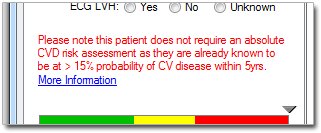How the Calculator Works
The Cardiovascular Risk Calculator is a calculator only; measurements entered, and values calculated can be saved within the calculator for viewing later, and the result can be saved back to the patient's Progress Notes. It is anticipated that the clinician will decide whether to use the Cardiovascular Risk Calculator based on clinical impression.
The calculator then acts at two levels;
- Identifying high-risk patients
- Cardiovascular disease; coronary heart disease (CHD), stroke and other vascular disease including peripheral arterial disease and renovascular disease. For a list of diagnosis descriptions that trigger automatic exclusion, see Absolute CVD Risk Diagnosis Descriptions.
- Patients age ≥ 75 years of age, including patients who identify themselves as ATSI.
- Patient is diabetic and is of age > 60 years. For a list of diagnosis descriptions that trigger automatic exclusion, see Absolute CVD Risk Diagnosis Descriptions.
- Diabetes with microalbuminuria (> 20 mcg/min or urinary albumin:creatinine ratio > 2.5 mg/mmol for males, > 3.5 mg/mmol for females). MedicalDirector Clinical does not currently flag patients with recorded 'diabetes with microalbuminuria' as high-risk.
- Moderate or severe chronic kidney disease (persistent proteinuria or estimated
glomerular filtration rate (eGFR) < 45 mL/min/1.73m2). Persistence of
proteinuria will only be able to be determined by clinical review by the
practitioner.
- For a list of diagnosis descriptions that trigger automatic exclusion, see Absolute CVD Risk Diagnosis Descriptions.
- Persistence of proteinuria will only be able to be determined by clinical review by the GP
- A previous diagnosis of familial hypercholesterolaemia. See 'Absolute CVD risk Diagnosis Descriptions'.
- Systolic blood pressure ≥ 180 mmHg or diastolic blood pressure ≥ 110 mmHg, as sourced from the most recent blood pressure 'sitting' data, recorded within the last 2 months.
- Serum total cholesterol > 7.5 mmol/L.Note: For such patients, you need not enter data into the calculator; you can simply click Save to automatically document the risk value as >15% in the Tool Box. This will also add a note to the patient's Progress Notes.
- Calculating absolute cardiovascular disease risk for patients who are:
- 45 to 74 years of age, who are not known to have cardiovascular disease.
- ATSI patients >34 years of age who are not known to have cardiovascular
disease.
Because the calculator gives you an estimate only of the patient's cardiovascular risk, it is recommended that you use it only for patients between 35 and 75 years of age;
For patients <35 years, the calculator will not attempt to calculate risk, displaying the message "Cardiovascular risk cannot be accurately determined below the age of 35 or above the age of 74".
The calculator is of no value to patients 75 years of age or older, as this group is automatically considered 'high risk'.
- Resources for health professionals and consumers are available online, here. The Cardiovascular Risk Calculator tool also displays these links for your convenience.
We recommend that you:
- Consider creating a Recall notification for your patient for an Absolute CVD Risk review.
- Ensure you have configured Clinical to notify you of eligible patients via the Preventive Health Prompts options.
